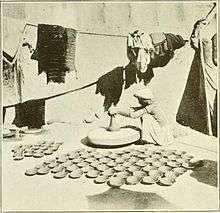Kumhar
Kumhar is a caste or community in India and Pakistan. Kumhar literally means potter in Indian languages.[1]
 | |
| Languages | |
|---|---|
| Hindi, Sindhi, Rajasthani, Haryanvi, Awadhi, Gujarati, Marathi, Punjabi |
Etymology
The Kumhars derive their name from the Sanskrit word Kumbhakar meaning earthen-pot maker.[2] Dravidian languages conform to the same meaning of the term Kumbhakar. The term Bhande, used to designate the Kumhar caste, also means pot. The potters of Amritsar are called Kulal or Kalal, the term used in Yajurveda to denote the potter class.[1]
Mythological origin
A section of Hindu Kumhars honorifically call themselves Prajapati after Vedic Prajapati, the Lord, who created the universe.[1]
According to a legend prevalent among Kumhars
Once Brahma divided sugarcane among his sons and each of them ate his share, but the Kumhara who was greatly absorbed in his work, forgot to eat. The piece which he had kept near his clay lump struck root and soon grew into a sugarcane plant. A few days later, when Brahma asked his sons for sugarcane, none of them could give it to him, excepting the Kumhara who offered a full plant. Brahma was pleased by the devotion of the potter to his work and awarded him the title Prajapati.[1]
There is an opinion that this is because of their traditional creative skills of pottery, they are regarded as Prajapati.[3]
Divisions
The potters are classified into Hindu and Muslim cultural groups.[1] Among Hindus, inclusion of artisan castes, such as potters, in the Shudra varna is indisputable. They are further divided into two groups-clean caste and unclean caste .[4]
Among the Kumhars are groups such as the Gujrati Kumhar, Rana Kumhar, Lad and Telangi. They all, bear these names after different cultural linguistic zones or caste groups but are termed as one caste cluster.[5]
Distribution in India
Chamba (Himanchal)
The Kumhars of Chamba are expert in making pitchers, Surahis, vessels, grain jars, toys for entertainment and earthen lamps. Some of these pots bear paintings and designs also.[3]
Maharashtra (Marathe)
Kumhars are found in Satara, Sangli, Kolhapur, Sholapur and Pune. They speak in Marathi among themselves but in Marathi as well as Hindi with outsiders. They use Devnagari script for communication.[6] There are Kumbhars who do not belong to Maratha clan lives in Maharashtra and have occupation of making idols and pots.[1] They are aware of the Hindu Varna hierarchy and consider themselves to be the Shudra, the lowest rank.[6]
Madhya Pradesh
Hathretie and Chakretie (or Challakad) Kumhars are found in Madhya Pradesh. Hathretie Kumhars are called so because they traditionally moved the "chak" (potter's wheel) by hands ("hath"). Gola is a common surname among Kumhars in Madhya Pradesh.[7] They are categorised as a Scheduled Caste in Chhatarpur, Datia, Panna, Satna, Tikamgarh, Sidhi and Shahdol districts[8] but elsewhere in the state they are listed among Other Backward Classes.[9]
Rajasthan
In Rajasthan, Kumhars (Also known as Prajapat) have six sub-groups namely Mathera, Kumavat, Kheteri, Marwara, Timria and Mawalia. In the social hierarchy of Rajasthan, they are placed in the middle of the higher castes and the Harijans. They follow endogamy with clan exogamy.[2]
Orissa and Bengal
In Bengal Kumhars are one among the ceremonially pure castes. The Jagannathia Kumhars of Orissa, who provide vessels for the rice distribution in Jagannath temple, have much higher rank in the society than the Kumhars of Central India.
Uttar Pradesh and Bihar
The Kannuaja Kumhars are considered to be a Shudra caste in both Bihar and Uttar Pradesh. Although they sometimes use the term Pandit with their names, they do so as a suffix rather than prefixing it in the honorific style that is used by Brahmins. The Magahiya Kumhars are treated little inferior to the Kanaujias and the Turkaha (Gadhere) Kumhars rank with untouchables.[10]
The Prajapati are among 17 OBC communities that were proposed for Scheduled Caste status by the Samajwadi Party-controlled Government of Uttar Pradesh in 2016. However, this proposal, which relates to votebank politics, has been stayed by the courts; the prior attempt had been rejected by the Government of India.[11][12]
Gujarat
Kumhars are listed among the Other Backward Classes of Gujarat, where they are listed with the following communities: Prajapati (Gujjar Prajapati, Varia Prajapati, Sorthia Prajapati), Sorathiya Prajapati.[13]
See also
References
| Wikimedia Commons has media related to Kumhar. |
- Saraswati, Baidyanath (1979). Pottery-Making Cultures And Indian Civilization. Abhinav Publications. pp. 46–47. ISBN 978-81-7017-091-4. Retrieved 6 April 2013.
- Mandal, S. K. (1998). "Kumhar/Kumbhar". In Singh, Kumar Suresh (ed.). People of India: Rajasthan. Popular Prakashan. pp. 565–566. ISBN 978-8-17154-769-2.
- Bhāratī, Ke. Āra (2001). Chamba Himalaya: Amazing Land, Unique Culture. Indus Publishing. p. 178. ISBN 978-8-17387-125-2.
- Saraswati, Baidyanath (1979). Pottery-Making Cultures And Indian Civilization. Abhinav Publications. p. 48. ISBN 978-81-7017-091-4. Retrieved 6 April 2013.
- Vidyarthi, Lalita Prasad (1976). Rise of Anthropology in India. Concept Publishing Company. p. 293.
- Khan, I. A. (2004). "Kumbhar/Kumhar". In Bhanu, B. V. (ed.). People of India: Maharashtra, Part 2. Popular Prakashan. pp. 1175–1176. ISBN 978-8-17991-101-3.
- "The Kumhars of Gwalior". Archived from the original on 23 March 2010.
- "Part IX - Madhya Pradesh" (PDF). DSJE, Government of India. Archived from the original (PDF) on 23 March 2016.
- "Central List of OBCs: State : Madhya Pradesh". National Commission for Backwards Classes. Retrieved 18 May 2019.
- Saraswati, Baidyanath (1979). Pottery-Making Cultures And Indian Civilization. Abhinav Publications. pp. 49–50. ISBN 978-81-7017-091-4. Retrieved 6 April 2013.
- "Setback for Akhilesh government as High Court stays their order to include 17 sub-castes in the SC category". Financial Express. 24 January 2017. Retrieved 4 February 2017.
- "UP govt to include 17 other backward castes in SC list". Hindustan Times. PTI. 22 December 2016. Retrieved 4 February 2017.
- "CENTRAL LIST OF OBCs FOR THE STATE OF GUJARAT" (PDF). Government of India.